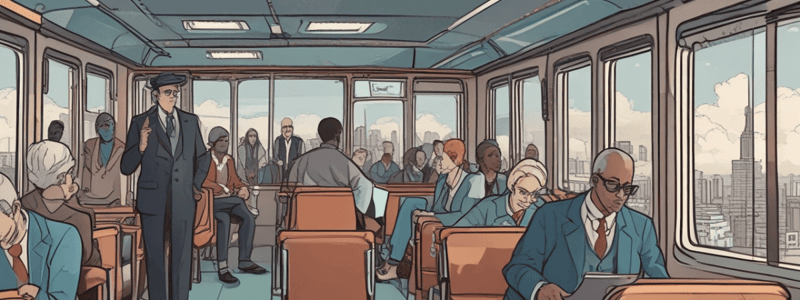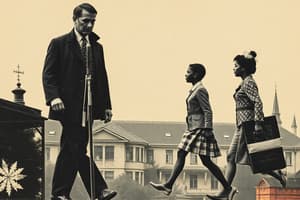Podcast
Questions and Answers
What is Ian's occupation?
What is Ian's occupation?
- Manual laborer
- CEO
- Accountant (correct)
- Factory worker
What would happen to Ian's social standing if he got a series of promotions and became the CEO of an international accounting firm?
What would happen to Ian's social standing if he got a series of promotions and became the CEO of an international accounting firm?
- He would move up to the upper class (correct)
- He would move down to the lower class
- He would stay in the same social class
- He would remain in the middle class
What is the term for the change in social mobility that Ian experiences in his own lifetime?
What is the term for the change in social mobility that Ian experiences in his own lifetime?
- Intergenerational mobility
- Social hierarchy
- Intragenerational mobility (correct)
- Class transition
What is the key difference between intragenerational mobility and intergenerational mobility?
What is the key difference between intragenerational mobility and intergenerational mobility?
What would happen to Ian's social standing if he got fired and ended up in a poorly paid manual job?
What would happen to Ian's social standing if he got fired and ended up in a poorly paid manual job?
Why is it important to consider Ian's lifetime when discussing intragenerational mobility?
Why is it important to consider Ian's lifetime when discussing intragenerational mobility?
What is the term for the change in social mobility that considers Ian's parents?
What is the term for the change in social mobility that considers Ian's parents?
What is the common theme between intragenerational mobility and intergenerational mobility?
What is the common theme between intragenerational mobility and intergenerational mobility?
What social class would Ian typically be considered as an accountant?
What social class would Ian typically be considered as an accountant?
What happens to Ian's social standing if he experiences intragenerational mobility?
What happens to Ian's social standing if he experiences intragenerational mobility?
Who is considered in addition to Ian when discussing intergenerational mobility?
Who is considered in addition to Ian when discussing intergenerational mobility?
What is a common theme among intragenerational and intergenerational mobility?
What is a common theme among intragenerational and intergenerational mobility?
What is the primary focus of intragenerational mobility?
What is the primary focus of intragenerational mobility?
Which of the following best describes the primary focus of intergenerational mobility?
Which of the following best describes the primary focus of intergenerational mobility?
What is a key assumption underlying the concept of social mobility?
What is a key assumption underlying the concept of social mobility?
How would Ian's social standing change if he experienced downward intragenerational mobility?
How would Ian's social standing change if he experienced downward intragenerational mobility?
What is the primary difference between intragenerational and intergenerational mobility in terms of timeframe?
What is the primary difference between intragenerational and intergenerational mobility in terms of timeframe?
What is a potential consequence of upward intragenerational mobility?
What is a potential consequence of upward intragenerational mobility?
Flashcards are hidden until you start studying
Study Notes
Social Mobility
- Ian, an accountant, is considered middle class in the social hierarchy, represented by a triangle with upper class at the top, middle class in the middle, and lower class at the bottom.
Intragenerational Mobility
- Refers to changes in social mobility that occur within an individual's lifetime, affecting their own generation.
- Example: Ian gets promotions, becomes CEO, and joins the upper class, or gets fired, takes a poorly paid job, and joins the working class or lower class.
- This type of mobility affects Ian in his own lifetime.
Intergenerational Mobility
- Refers to changes in social mobility that occur across generations, considering the social standing of parents and their children.
- Example: Ian's parents are manual workers (lower class), while Ian becomes a CEO (upper class), showing a change in social group from lower to upper class across generations.
- This type of mobility considers changes in social mobility between parents and their children.
Key Concepts
- Intragenerational mobility focuses on changes within an individual's lifetime.
- Intergenerational mobility focuses on changes across generations, considering parents and their children.
- Both concepts describe types of social mobility, particularly upward or downward movement in the social hierarchy.
Social Mobility
- Ian, an accountant, is considered middle class in the social hierarchy, represented by a triangle with upper class at the top, middle class in the middle, and lower class at the bottom.
Intragenerational Mobility
- Refers to changes in social mobility that occur within an individual's lifetime, affecting their own generation.
- Example: Ian gets promotions, becomes CEO, and joins the upper class, or gets fired, takes a poorly paid job, and joins the working class or lower class.
- This type of mobility affects Ian in his own lifetime.
Intergenerational Mobility
- Refers to changes in social mobility that occur across generations, considering the social standing of parents and their children.
- Example: Ian's parents are manual workers (lower class), while Ian becomes a CEO (upper class), showing a change in social group from lower to upper class across generations.
- This type of mobility considers changes in social mobility between parents and their children.
Key Concepts
- Intragenerational mobility focuses on changes within an individual's lifetime.
- Intergenerational mobility focuses on changes across generations, considering parents and their children.
- Both concepts describe types of social mobility, particularly upward or downward movement in the social hierarchy.
Social Mobility
- Ian, an accountant, is considered middle class in the social hierarchy, represented by a triangle with upper class at the top, middle class in the middle, and lower class at the bottom.
Intragenerational Mobility
- Refers to changes in social mobility that occur within an individual's lifetime, affecting their own generation.
- Example: Ian gets promotions, becomes CEO, and joins the upper class, or gets fired, takes a poorly paid job, and joins the working class or lower class.
- This type of mobility affects Ian in his own lifetime.
Intergenerational Mobility
- Refers to changes in social mobility that occur across generations, considering the social standing of parents and their children.
- Example: Ian's parents are manual workers (lower class), while Ian becomes a CEO (upper class), showing a change in social group from lower to upper class across generations.
- This type of mobility considers changes in social mobility between parents and their children.
Key Concepts
- Intragenerational mobility focuses on changes within an individual's lifetime.
- Intergenerational mobility focuses on changes across generations, considering parents and their children.
- Both concepts describe types of social mobility, particularly upward or downward movement in the social hierarchy.
Studying That Suits You
Use AI to generate personalized quizzes and flashcards to suit your learning preferences.




